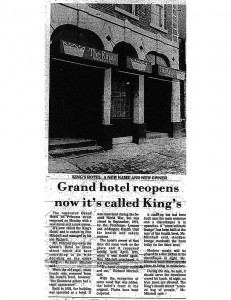Street Address : 76 Princess St.
Period : After 1950
On March 1, 1977, the Kingston Whig-Standard ran a story announcing the opening of the King’s Hotel, a new bar situated right downtown on Princess Street, where the Toucan currently stands. In its former incarnation as the Grand, it had been one of the working class bars where gays and lesbians were “tolerated or at least not noticed”. New ownership and the accompanying renovations were heralded by the Whig as a vast improvement. “That was the hot spot,” recalls Harvey, “it was the Studio 54 of Kingston.” Owner Richard Mitchell expected that the King’s would draw “a mixed bag of people”, but on the King’s opening night it became apparent that Mitchell’s “mixed bag” did not include homosexuals.
Approximately 10 members of the Queen’s Homophile Association went to the King’s that night to “have a look at the place and see what it was like.” Recalls Dan, “we really wanted to have a gay bar, and since no one of us was in the position to open one we kind of thought we would, not exactly try to take one over, find one where we would be more welcome and that could become known as sort of the gay hangout, because the Plaza was not really all that comfortable…so when the bar opened on Princess St., we got in there early so to speak.”
QHA members danced in male/female couples and then on a predetermined signal switched partners. “I guess we made it quite obvious that we were dancing with each other,” Dan recounts. “Now this was not a close dance, we didn’t have our arms around each other, there was no physical contact but we were clearly dancing with one another, um, and, um, I don’t know whether we even made it to the end of the first song, um, but certainly it wasn’t long before the manager of assistant manager came over to us and said.. that we couldn’t do this, it wasn’t allowed.”
Members of the QHA were outraged not only that they had been told to leave, but that the same-sex dancing that took place between two women was permitted. Mitchell commented in the Whig that “I’ve seen girls together frequently, but it doesn’t conjure up in my mind that they might be funny. But two men doing a dance where each partner holds each other was offensive to me and everyone in the place. I don’t have anything against these people, I feel sorry for them. But I’m a business man, not a sociologist.”
The QHA protested Mitchell’s actions on the grounds that they were both anti-gay and sexist. Subsequent phone calls to the King’s established that Mitchell had no intention to change his policy except to apply the rule to women as well. In response, members of the QHA decided to organize a picket. On Saturday afternoon, March 12, betweens 25 and 30 gay people and supporters gathered on the sidewalk outside the King’s to protest the owner’s actions. Picketers held signs that read “The King’s is sexist”, “Anti-gay is sick”, “discrimination lives here” and “gay is proud”, and the action attracted some 130 spectators, who stood quietly watching from the other side of the street. A reporter from the Whig interviewed protesters and the next day a photo of the protest appeared on the front page of the paper.
Picketers recall that the beginning of the protest, when numbers were still small, was frightening because the protesters felt conspicuous, and indeed the Whig quoted one 14-year-old girl as commenting that she “can’t believe people would get up on Princess Street and admit they’re gay”. In addition, not all QHA members agreed with the protest, which they felt attracted negative attention rather than promoting the organization’s efforts to create a supportive environment for gays and lesbians. According to Harvey, the QHA felt the repercussions of the picket for years afterward. Anxious callers to the Gay Rap Line would express a fear of being on the front page of the paper if they joined the QHA.
Unfortunately, the protest appeared to have little effect on the King’s except to cause Mitchell to declare that he would no longer serve members of the QHA “if I am able to recognize them”. Although the action did not change the King’s policy, the fact that thirty people openly and without shame or incident demonstrated for gay rights on a busy Kingston street was a formidable accomplishment.


